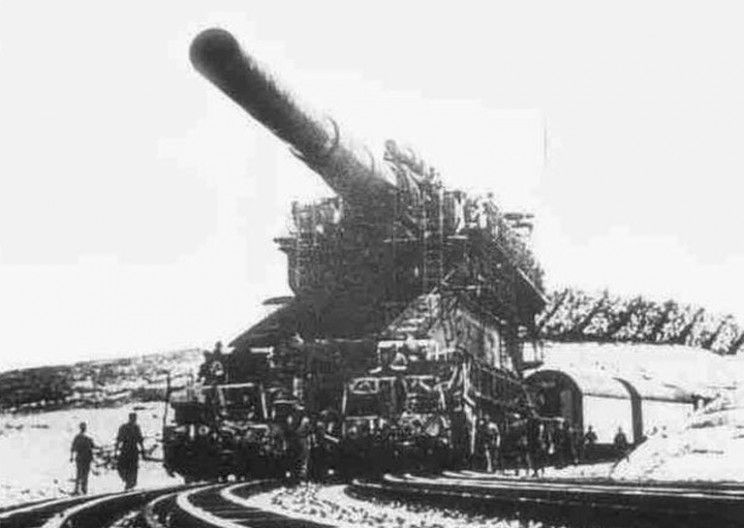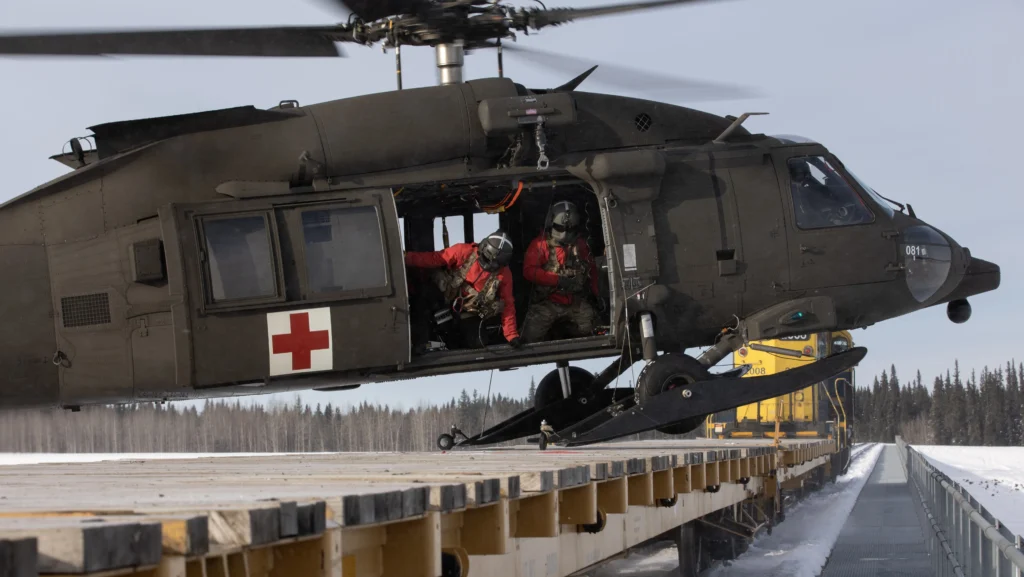The Nazi Schwerer Gustav rail gun: Big bang for the buck, or small spark for the Reichsmark?
- By George Hand
Share This Article

You know what they say: ‘The bigger the gun… the bigger the bullet.” Such is the case with the mammoth Nazi railway gun, the Schwerer Gustav. Most people can only look at such barbarism, shake their heads, and wonder of Hitler: “what is this monster thinking?”
It is the modus operandi of some countries — Germany of the past, Russian, and China — to rally around their military chest-thumping parades. They get out their military machinery, wash it all down, paint nice straight white accent lines on it and parade it down avenues and boulevards along with tens of thousands of goose-stepping troops.
The message is clear to other countries:
“This is what we are going to send to your homeland to kick your a**es if you don’t let us have our way with you.”
Size clearly matters to the Russians and the Germans; they two were constantly engaged in a morbid race to produce the largest of the large — the largest aircraft or largest battleship. Consider Germany’s Bismarck and Japan’s Yamato battleships: America had nothing as big and powerful as those two ships, and yet they both looked equally bad**s as they sank to the bottom of the sea aided by Allied combat power.
Related: Zero: Did Japan have the best fighter plane of World War II?
The Schwerer Gustav to counter French defenses

The Schwerer Gustav — “schwerer” meaning “large,” and “Gustav” for the name of the contract builder Gustav Krupp — weighed approximately 1,350 (short) tons! It could engage targets out to 43 kilometers with a variety of munitions including a seven-ton armor-piercing and a 5-ton high explosive warhead. The shells’ (caliber) were approximately 30” in diameter.
The original purpose for the creation of the Schwerer Gustav was to destroy the French Maginot line, a line of formidable fortifications encircling France to protect her from a German invasion. The French had built the Maginot line to prevent another German attack and partly in response to the increasing German rearmament which was contrary to the Treaty of Versailles signed after WWI.
Maginot Line be damned and the Germans, rather than chip away at it, just decided to move up north and skirt around it, entering France through Belgium and the Netherlands.
The Germans, learning of a weak point in the French lines of defense at the Ardennes Forest in Belgium, cut a quick swath through the Ardennes, crossed the Meuse River, and encircled a substantial allied force whose only chance for survival was to be evacuated from — you guessed it — Dunkirk.
Related: 10 military movies to watch in the barracks when you’re bored
A giant with feet of clay

I have so far steered the essay to make the Schwerer Gustav sound like the hero of the Reich, but now the truth: inevitably, the gun was a flop that amounted to no real strategic or tactical value. It was for the most part a waste of time; a solution looking for a problem. Granted, a good many fine upstanding citizens of French and Russian persuasion who were shot at by the gun may have widely varying opinions.
The gun initially fired about 220 rounds in development, testing, and tweaking. Then it took a position on the battlefield and fired 44 rounds in combat (14 rounds per day)… and the barrel was shot out; no good anymore. So the barrels were only serviceable for about 300 shots before needing replacement — not a good bang for the buck or a great spark for the Reichsmark — Germany’s currency at the time.
And the problems continued. Probably the gun’s biggest problem was its lack of mobility. The Schwerer Gustav ran on a complex compound rail system that took thousands of laborers’ days to build straight out in front of the gun. Finally, it needed a curved section of track so it could achieve deviations and deflections for hitting targets that were off-aim from the straight rails. It puts me in mind of the timeless claymation work from Wallace and Gromit:
Lastly, it took some 250 men to operate the gun and it was greatly exposed to any aircraft flying nearby.
The gun was finally scrapped, its parts scattered and hidden to prevent it from being captured by the allies. I think the only Germans sincerely ever pleased with the gun were Hitler and Alpert Speer.
Bigger is bigger; but is not necessarily better in an armed struggle as the Schwerer Gustav gun demonstrates.
By Almighty God and with honor,
geo sends
Read more from Sandboxx News
- How the Army-Navy game of 1944 stopped World War II
- Nazi Germany’s V-2 vengeance missile: The first human object to reach space
- Night Witches: The female pilots who struck fear into the Nazis
- Guile, violence, and intelligence – The tools of the WW2 spy
- The Army has an artillery problem (and some high tech solutions)
Related Posts
Sandboxx News Merch
-

‘Sandboxx News’ Dad Hat
$27.00 Select options This product has multiple variants. The options may be chosen on the product page -

‘AirPower’ Golf Rope Hat
$31.00 Select options This product has multiple variants. The options may be chosen on the product page -

‘Kinetic Diplomacy’ Bumper Sticker (White)
$8.00 Add to cart
George Hand
Master Sergeant US Army (ret) from the 1st Special Forces Operational Detachment-Delta, The Delta Force. In service, he maintained a high level of proficiency in 6 foreign languages. Post military, George worked as a subcontracter for the U.S. Department of Energy (DOE) on the nuclear test site north of Las Vegas Nevada for 16 years. Currently, George works as an Intelligence Analyst and street operative in the fight against human trafficking. A master cabinet-grade woodworker and master photographer, George is a man of diverse interests and broad talents.
Related to: Military History

This is how Navy SEALs conduct “over-the-beach” operations

A Delta man’s failure to follow instructions was more than it seemed

Soldiers in Alaska landed their Black Hawk on a train in a special ops exercise

Fixing the US Navy’s shipbuilding problems starts with the workers, agency analysts say
Sandboxx News
-

‘Sandboxx News’ Trucker Cap
$27.00 Select options This product has multiple variants. The options may be chosen on the product page -

‘AirPower’ Classic Hoodie
$46.00 – $48.00 Select options This product has multiple variants. The options may be chosen on the product page -

‘AirPower’ Golf Rope Hat
$31.00 Select options This product has multiple variants. The options may be chosen on the product page -

‘Sandboxx News’ Dad Hat
$27.00 Select options This product has multiple variants. The options may be chosen on the product page
